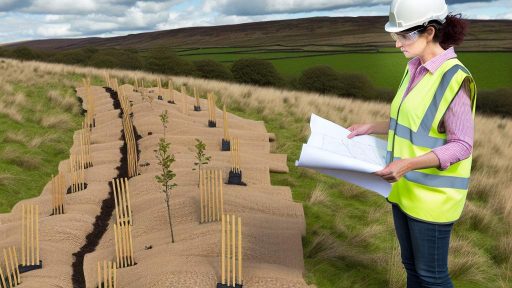Understanding Soil Composition: Key Nutrients and Minerals
The Importance of Soil Composition
Soi! composition plays a vital role in agricultural productivity.
It determines how well crops can grow in a given area.
Farmers must understand the key components of their soil before purchasing land.
Essential Nutrients for Plants
Plants require a variety of nutrients to thrive.
The most important nutrients are nitrogen, phosphorus, and potassium.
Nitrogen promotes vigorous growth and green foliage.
Phosphorus supports root development and flowering.
Potassium enhances overall plant health and disease resistance.
Micro and Macronutrients
In addition to major nutrients, plants also need micronutrients.
Micronutrients include iron, manganese, and zinc.
These elements play crucial roles in various plant functions.
While needed in smaller quantities, they are essential for optimal growth.
Soil pH and Its Influence
Soil pH significantly affects nutrient availability for plants.
Most crops thrive in a pH range of 6.0 to 7.5.
Acidic or alkaline conditions can hinder nutrient absorption.
Transform Your Agribusiness
Unlock your farm's potential with expert advice tailored to your needs. Get actionable steps that drive real results.
Get StartedTesting soil pH is essential before buying agricultural land.
Soil Organic Matter
Organic matter improves soil structure and fertility.
It aids in moisture retention and provides a habitat for beneficial organisms.
Higher levels of organic matter correlate with healthier soil.
Farmers should evaluate organic matter content in potential land.
Impact of Soil Texture
Soil texture describes the size of soil particles.
It affects water retention and drainage capacity.
Sandy soils drain quickly, while clayey soils retain moisture.
Loamy soils are often the best for farming, combining both properties.
Conducting Soil Tests
Performing soil tests provides valuable insights into soil health.
Tests can reveal nutrient levels, pH, and organic matter content.
Farmers should consider regular testing a routine part of land assessment.
These test results guide decisions on soil amendments and management practices.
Evaluating Soil pH Levels and Their Impact on Crop Growth
Understanding Soil pH
Soil pH measures the acidity or alkalinity of soil.
It significantly affects nutrient availability to plants.
The scale ranges from 0 to 14, with 7 being neutral.
Values below 7 indicate acidic soil, while values above 7 are alkaline.
Importance of Soil pH in Agriculture
Soil pH affects crop growth directly and indirectly.
Acidic soils can lead to nutrient deficiencies.
On the other hand, alkaline soils may cause nutrient toxicities.
Both extremes can hinder optimal plant development.
Assessing Soil pH
Testing soil pH is a crucial step before purchasing land.
You can perform soil tests through local agricultural extensions.
Home testing kits are also widely available for individual assessments.
Showcase Your Farming Business
Publish your professional farming services profile on our blog for a one-time fee of $200 and reach a dedicated audience of farmers and agribusiness owners.
Publish Your ProfileRegular testing helps track changes over time.
Addressing Soil pH Issues
Adjusting soil pH can improve agricultural productivity.
For acidic soils, applying lime can increase pH levels.
Conversely, sulfur can lower pH for alkaline soils.
Both methods require careful planning and execution.
Crop-Specific pH Requirements
Different crops have unique soil pH preferences.
Cereal crops often thrive in slightly acidic to neutral soils.
Legumes generally prefer neutral to slightly alkaline conditions.
Understanding these preferences helps in planning crop rotations.
Assessing Soil Texture
The role of sand is crucial in soil texture.
Sand provides good drainage and aeration.
This is essential for root growth.
Moreover, sandy soils warm up quickly in the spring.
Farmers often find them easier to cultivate.
The Role of Silt
Silt contributes to soil fertility and moisture retention.
Silt holds nutrients better than sand.
Consequently, it supports healthy plant growth.
Furthermore, silt particles help improve soil structure.
This enhances the soil’s ability to retain water.
The Role of Clay
Clay has fine particles that hold water effectively.
It contributes significantly to soil richness.
However, clay can lead to poor drainage if too dense.
To counteract this, farmers can amend clay soils.
Adding organic matter helps improve their structure.
Balancing the Three Components
Finding the right balance of sand, silt, and clay is vital.
A balanced texture improves crop performance.
It enhances the soil’s ability to provide nutrients.
Additionally, it influences water retention capabilities.
Thus, assessing the soil’s texture is essential before purchasing land.
Delve into the Subject: Water Conservation Techniques for Sustainable Farm Real Estate Growth
Investigating Organic Matter Content and Soil Health
Understanding Organic Matter
Organic matter significantly influences soil health.
It comprises decomposed plant and animal materials.
High organic matter content enhances soil structure.
Additionally, it improves water retention and nutrient availability.
Importance of Soil Testing
Testing soil is crucial before purchasing agricultural land.
A comprehensive analysis reveals organic matter levels.
Consider hiring professionals for an accurate assessment.
They will provide insights tailored to your land’s needs.
Assessing Organic Matter Content
One effective method is the soil test kit.
These kits measure organic matter percentages easily.
Showcase Your Farming Business
Publish your professional farming services profile on our blog for a one-time fee of $200 and reach a dedicated audience of farmers and agribusiness owners.
Publish Your ProfileLook for values above 5% for optimal health.
Low organic matter indicates potential issues.
Impacts on Crop Production
Healthy organic matter levels promote robust crop yields.
They foster beneficial microbial activity within the soil.
Furthermore, organic matter aids in disease suppression.
This support translates into healthier plants and higher profits.
Strategies for Improving Organic Matter
- Incorporate cover crops into farming practices.
- Utilize crop rotation to enhance diversity.
- Add compost or manure to enrich soil.
Employing these strategies boosts organic matter over time.
Ultimately, these efforts lead to improved soil health.
Discover More: Why Sustainable Irrigation Is Essential for Long-Term Land Investment
Examining Soil Drainage and Water Holding Capacity
Importance of Soil Drainage
Soil drainage significantly affects crop productivity.
Good drainage prevents waterlogging, which harms plants.
It encourages healthier root development and nutrient uptake.
Farmers should assess drainage capacity before purchasing land.
Drainage also influences soil aeration, which is crucial for plant growth.
Methods to Evaluate Drainage
Several methods exist to test soil drainage effectively.
A standard technique involves using a drainage test pit.
Dig a pit, fill it with water, and measure how quickly it drains.
This method provides insight into the soil’s drainage capabilities.
Alternatively, observe the land after heavy rainfall.
Look for areas that retain water for extended periods.
Understanding Water Holding Capacity
Water holding capacity directly impacts crop sustainability.
Soil rich in organic matter retains moisture more effectively.
This characteristic assists during dry spells, supporting crop health.
Farmers should prioritize land with optimal water holding capacity.
Measuring soil texture helps gauge this property.
Evaluating Soil Texture
Soil texture includes clay, silt, and sand proportions.
Clay soils hold more moisture but may drain poorly.
Sand soils drain quickly but often lack water retention.
Ideal soils balance these textures for optimal performance.
Linking Drainage and Water Holding
Soil drainage and water holding capacity are interconnected.
Poor drainage can lead to reduced water availability.
Consequently, understanding both factors benefits potential landbuyers.
Farmers need to consider both qualities for long-term success.
Uncover the Details: Climate Change Regulations Affecting Agricultural Real Estate Buyers

Identifying Soil Microbial Activity and Its Importance
Understanding Soil Microbial Activity
Soil microbial activity refers to the processes carried out by microorganisms in the soil.
These microorganisms include bacteria, fungi, and protozoa.
They play a vital role in soil health and fertility.
Microbial activity influences nutrient cycling and organic matter decomposition.
Without these microorganisms, soil ecosystems would struggle to thrive.
The Role of Microorganisms
Microorganisms help break down organic materials in the soil.
Showcase Your Farming Business
Publish your professional farming services profile on our blog for a one-time fee of $200 and reach a dedicated audience of farmers and agribusiness owners.
Publish Your ProfileThis process releases essential nutrients for plant growth.
They also assist in forming soil structure, improving aeration and water retention.
Furthermore, they can suppress harmful pathogens, promoting plant health.
Overall, active microorganisms enhance soil resilience.
Benefits of Assessing Microbial Activity
Before purchasing agricultural land, evaluate the soil’s microbial activity.
Healthy microbial communities indicate fertile soil.
High microbial activity correlates with enhanced productivity.
Assessing microbial activity helps identify potential land management practices.
Additionally, it provides insights into the land’s ecological balance.
Methods of Assessment
Several methods exist for assessing microbial activity in the soil.
Soil respiration tests measure carbon dioxide production.
Microbial biomass can be quantified using various extraction methods.
Enzyme activity tests evaluate specific microbial functions in the soil.
Each method provides valuable information on soil health.
Find Out More: Water-Saving Irrigation Techniques for Sustainable Agricultural Growth
Analyzing Soil Erosion Risks and Land Management Practices
Identifying Soil Erosion Risks
Understanding soil erosion risks is essential for maintaining land productivity.
Factors such as topography and soil type greatly influence erosion potential.
Steep slopes typically experience higher erosion rates compared to flatter areas.
Additionally, soil texture plays a significant role in erosion resistance.
For instance, sandy soils erode more easily than clay soils.
Identifying vegetation type can also provide insights into erosion risks.
Lush vegetation helps stabilize soil and reduce erosion.
In contrast, bare soil is more susceptible to erosion by wind and water.
Evaluating Land Management Practices
Effective land management practices can significantly mitigate soil erosion.
Implementing crop rotation enhances soil structure and fertility.
It helps prevent the depletion of specific nutrients in the soil.
Cover cropping is another effective strategy to protect the soil.
Cover crops retain moisture and add organic matter to the soil.
Additionally, no-till farming reduces soil disturbance, preserving structure.
Regularly monitoring soil health is vital for effective management.
Soil testing reveals nutrient levels and informs management decisions.
Utilizing Conservation Practices
Employing conservation practices further protects the soil from erosion.
Contour farming follows the natural contours of the land.
This method reduces runoff and promotes water infiltration.
Terracing can also be beneficial on steep slopes.
It creates level areas that slow water runoff and reduce erosion.
Buffer strips near water bodies capture sediment before it enters water systems.
Implementing these practices enhances long-term soil health and productivity.
Considering Historical Land Use and Its Effects on Soil Quality
Understanding Historical Practices
Historical land use significantly impacts current soil health.
Past agricultural practices can deplete soil nutrients.
Showcase Your Farming Business
Publish your professional farming services profile on our blog for a one-time fee of $200 and reach a dedicated audience of farmers and agribusiness owners.
Publish Your ProfileThese practices might also lead to soil compaction and erosion.
Understanding previous land management helps assess potential risks.
Assessing Soil Degradation
Soi degradation results from poor historical practices.
This degradation can take many forms, including erosion and nutrient loss.
Evaluating soil profiles reveals past problems and current conditions.
Additionally, testing soil quality indicates restoration needs.
Identifying Crop Rotation History
Crop rotation influences soil fertility and structure.
Repeated planting of the same crops can diminish soil quality.
Historical crop rotations can provide insights into soil health.
Furthermore, knowing past crop success can guide future planting strategies.
Investigating Chemical Inputs
The application of fertilizers and pesticides affects soil health.
Excessive chemical use can lead to soil contamination.
Confirm the types and amounts of chemicals used historically.
This knowledge allows for safer, sustainable farming practices.
Recognizing Land Restoration Efforts
Past land restoration efforts can enhance current soil health.
Programs aimed at rehabilitating degraded areas offer valuable lessons.
Review any conservation practices implemented historically.
Such practices may reveal how to maintain and improve soil care.
Additional Resources
Understanding why farmers adopt soil conservation tillage: A …
USDA Science and Research Strategy, 2023-2026: Cultivating …




